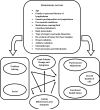Best Practice Guidelines in Assessment, Risk Reduction, Management, and Surveillance for Post-Breast Cancer Lymphedema
- PMID: 26246870
- PMCID: PMC4523280
- DOI: 10.1007/s12609-013-0105-0
Best Practice Guidelines in Assessment, Risk Reduction, Management, and Surveillance for Post-Breast Cancer Lymphedema
Abstract
Breast cancer-related lymphedema (LE) is a progressive, chronic disease that affects millions of cancer survivors and primarily results from surgical lymphatic vessel/node removal and radiation therapy. Patient education and support for importance of early detection is essential in helping health care providers detect lymphedema early, when there is the best chance to prevent progression. Improved imaging and surgical techniques have decreased the incidence of LE; however, effective risk-reduction and treatment have historically lacked the level of evidence necessary to standardize effective treatment. The purpose of this article is to report an extensive review of literature, including highlighted multidisciplinary studies within the past three years, in order to update best practice guidelines in assessment, risk reduction, management, and surveillance for post-breast cancer lymphedema.
Keywords: Breast cancer; Combined decongestive therapy; Complementary; Compression garment; Exercise; Intermittent pneumatic compression pump; Limb volume; Lymphatic; Lymphedema; Management; Manual lymphatic drainage; Practices; Risk reduction; Surveillance.
Figures

References
-
- American Cancer Society . The global economic cost of cancer. American Cancer Society; Atlanta: 2010. [February 22, 2013]. Available at http://www.cancer.org/acs/groups/content/@internationalaffairs/documents....
-
- Rockson SG, Rivera KK. Estimating the population burden of lymphedema. Ann New York Academy of Sciences. 2008;1131:147–54. - PubMed
-
- Armer JM, Stewart BR. Post-breast cancer lymphedema: Incidence increases from 12 to 30 to 60 months. Lymphology. 2010;43:118–27. [This study followed survivors’ limb volume change from pre-surgery through 57 months post-surgery using the four most commonly cited diagnostic criteria (2 cm circumferential change, 200 mL perometry LVC, 10% perometry LVC, and signs/symptoms) and found that the 2 cm criteria remains the most liberal definition of LE, followed by the 200mL perometry criteria.] - PMC - PubMed
-
- Földi M, Földi E, Kubik S. Textbook of lymphology: For physicians and lymphedema therapists. Urban and Fisher; San Francisco, CA: 2003.
-
- Hayes S, Di Sipio T, Rye S, et al. Prevalence and prognostic significance of secondary lymphedema following breast cancer. Lymphat Res Biol. 2011;9(3):135–41. - PubMed
Grants and funding
LinkOut - more resources
Full Text Sources
Other Literature Sources
Medical
Miscellaneous
